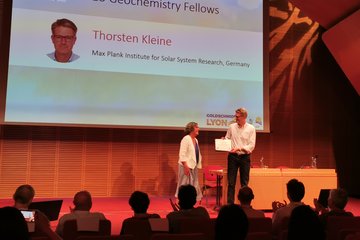Alle Typen
121.
Zeitschriftenartikel
Origin of isotopic heterogeneity in the solar nebula by thermal processing and mixing of nebular dust. Earth and Planetary Science Letters 357, S. 298 - 307 (2012)
122.
Zeitschriftenartikel
Nucleosynthetic Tungsten Isotope Anomalies in Acid Leachates of the Murchison Chondrite: Implications for Hafnium-Tungsten Chronometry. The Astrophysical Journal 753, S. L6 (2012)
123.
Zeitschriftenartikel
Thermal evolution and sintering of chondritic planetesimals. Astronomy and Astrophysics 537, S. A45 (2012)
124.
Zeitschriftenartikel
Thermal evolution and sintering of chondritic planetesimals. Astronomy and Astrophysics 537, S. A45 (2012)
125.
Zeitschriftenartikel
Chronology of the angrite parent body and implications for core formation in protoplanets. Geochimica et Cosmochimica Acta 84, S. 186 - 203 (2012)
126.
Zeitschriftenartikel
Hf-W chronometry of core formation in planetesimals inferred from weakly irradiated iron meteorites. Geochimica et Cosmochimica Acta 99, S. 287 - 304 (2012)
127.
Zeitschriftenartikel
Refractory element fractionation in the Allende meteorite: Implications for solar nebula condensation and the chondritic composition of planetary bodies. Geochimica et Cosmochimica Acta 85, S. 114 - 141 (2012)
128.
Zeitschriftenartikel
Molybdenum isotope anomalies in meteorites: Constraints on solar nebula evolution and origin of the Earth. Earth and Planetary Science Letters 312, S. 390 - 400 (2011)
129.
Zeitschriftenartikel
Geoscience: Earth's patchy late veneer. Nature 477, S. 168 - 169 (2011)
130.
Zeitschriftenartikel
Chronometry of Meteorites and the Formation of the Earth and Moon. Elements 7, S. 41 - 46 (2011)
131.
Zeitschriftenartikel
Tungsten isotopic evolution during late-stage accretion: Constraints on Earth-Moon equilibration. Earth and Planetary Science Letters 292, S. 363 - 370 (2010)
132.
Zeitschriftenartikel
Broad bounds on Earth's accretion and core formation constrained by geochemical models. Nature Geoscience 3, S. 439 - 443 (2010)
133.
Zeitschriftenartikel
Si isotope systematics of meteorites and terrestrial peridotites: implications for Mg/Si fractionation in the solar nebula and for Si in the Earth's core. Earth and Planetary Science Letters 287, S. 77 - 85 (2009)
134.
Zeitschriftenartikel
Hf-W chronology of the accretion and early evolution of asteroids and terrestrial planets. Geochimica et Cosmochimica Acta 73, S. 5150 - 5188 (2009)
135.
Zeitschriftenartikel
The distribution of short-lived radioisotopes in the early solar system and the chronology of asteroid accretion, differentiation, and secondary mineralization. Geochimica et Cosmochimica Acta 73, S. 5115 - 5136 (2009)
136.
Zeitschriftenartikel
Tungsten isotopes in ferroan anorthosites: Implications for the age of the Moon and lifetime of its magma ocean. Icarus 199, S. 245 - 249 (2009)
137.
Zeitschriftenartikel
Hf-W thermochronometry: II. Accretion and thermal history of the acapulcoite-lodranite parent body. Earth and Planetary Science Letters 284, S. 168 - 178 (2009)
138.
Zeitschriftenartikel
Early differentiation of the Earth and the Moon. Philosophical Transactions of the Royal Society of London Series A 366, S. 4105 - 4128 (2008)
139.
Zeitschriftenartikel
Hf W mineral isochron for Ca,Al-rich inclusions: Age of the solar system and the timing of core formation in planetesimals. Geochimica et Cosmochimica Acta 72, S. 6177 - 6197 (2008)
140.
Zeitschriftenartikel
Hf-W thermochronometry: Closure temperature and constraints on the accretion and cooling history of the H chondrite parent body. Earth and Planetary Science Letters 270, S. 106 - 118 (2008)











